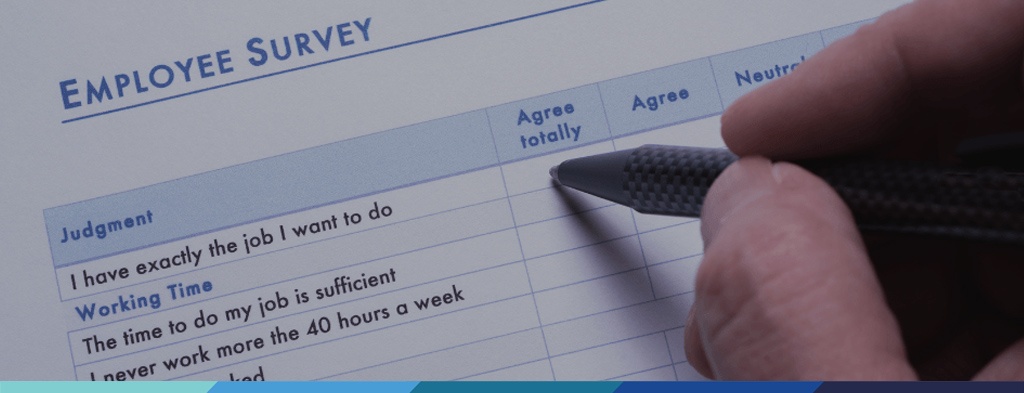
How regular employee surveys can improve business performance
by Tanya Gray | Jan 9, 2023 | ConsultingHQ Blog, Employee Surveys, Workplace Wellbeing

Is it a good idea to do frequent employee surveys?
- What is a pulse survey?
- Regular Employee Surveys – what is involved?
- Regular employee surveys can improve employee performance
- Employee short surveys give employers better HR information
- However frequent employee surveys do have some disadvantages
- Inclusions for a good employee survey:
- Benefits of high employee engagement
- Are there any tools that can help with employee surveys and pulse checks?
- Introducing the People Management Toolkit in EMS Hub
Short, regular employee surveys are called Pulse Checks, and are one of the different types of employee surveys an organisation can undertake.
What is a pulse survey?
An employee pulse check or survey is a fast and frequent survey system, that does away with complex questions and is intentionally designed to be undertaken more frequently than the commonly used employee engagement survey.
Pulse surveys can be held monthly or quarterly (even weekly) and provide employers with a quick insight into the health of a company, hence the name ‘pulse’.
Regular Employee Surveys – what is involved?
Pulse surveys are typically made up of only 5-15 targeted questions, and are very quick easy for people to respond to. They are useful because the feedback your employees give can help you decide which areas need improvement and form the basis of a regular measure of changes in employee engagement and satisfaction levels within your business.
Regular employee surveys can improve employee performance
- Employee engagement increases – by asking your team regularly for their feedback, you are encouraging positive engagement which also provides benefits such as:
- Employee satisfaction. as employees become more engaged with their organisation, their job satisfaction levels rise, and they become more invested in the success of their organisation;
- Employee Productivity: employees that are more engaged are found to be the top performers in an organisation. With higher motivation, they are driven to succeed;
- Employee Retention: employees are far more likely to stay with an organisation when they are engaged and satisfied with their current job; and
Profitability: when employees are more engaged, they tend to have higher profitability rates as they are more productive and motivated to be successful.
Employee short surveys give employers better HR information
- More relevant feedback – as pulse surveys are sent out regularly, you are getting a better look at how things are going ‘right now’ in the business rather than waiting each year to gain insights.
- Culture – a happier, more positive culture is created in an organisation that is focused on listening to their people and actively working on initiatives to improve engagement.
- Motivation – based on the responses you get from ongoing, regular pulse surveys you will have a better understanding of what motivates your people throughout the year.
- Quick and easy to complete – because they are short and sweet, these surveys are not time consuming and allow for employees to give their honest input in a timely matter. This means that participation rates are higher on pulse surveys than the less frequent alternatives.
Supports open communication – the ability to express your thoughts, concerns, and motivations is important in an organisation. By showing your people that you care to listen, they will feel more comfortable giving their honest feedback.
However frequent employee surveys do have some disadvantages
- Employee surveys with high frequency can become less effective, as people begin to get ‘survey fatigue’.
- Surveys should not be more frequent than fortnightly at most.
- Poor communication and no follow-up – by running Pulse surveys employers are setting up expectations that ‘things will be done’. Therefore, because employees are putting in the effort to give their honest feedback, proper action must be taken after evaluating the feedback. If you do not do anything in response to what they say, they will be discouraged to providing their feedback in the future. Hence you need to ensure you have appropriate resources available to communicate with employees and act on their feedback (which is the expectation you are setting).
Inclusions for a good employee survey:
- Select topics and questions you want to get feedback on e.g. choose 5-15 questions that you would like your employees to answer that will add value and insight to your business. These questions can cover a variety of topics, such as motivations, happiness, feelings about management, recognition, workload, job role, etc.
- Develop a solid employee communication plan to run before, during and after the survey and ensure you stick to the plan.
- Analyse the responses upon completion – look at areas that feedback has shown need to be improved, as well as reflecting on the positive areas.
- Analyse trend data, showing how results in each key area is changing over time.
In accordance with your communication plan, share the results with employees in a timely manner. - Take action – this is the most important step! Develop an action plan that includes key dates and who the person is who is responsible for delivering each item.
- Review and repeat – repeat pulse surveys regularly. Continue to review responses and see if progress is being made with the changes you implemented.
Benefits of high employee engagement
- Fully engaged teams perform significantly better than less engaged teams.
- Statistics show that 87% of employees worldwide are not engaged at work. Businesses with highly engaged employees have been proven to outperform those who do not significantly in earnings per share.
- Teams that are highly engaged have cultures that are safe and empowering, which is reflected in increased wellness and wellbeing.
- Given everything that our people have been through with Covid-19 over the last year or so, now is definitely a good time to do a pulse check with your team to see how they are currently feeling about their roles, communication, relationships, the work environment, and their general satisfaction.
Are there any tools that can help with employee surveys and pulse checks?
Although free tools such as Google Forms and SurveyMonkey are popular, they lend themselves to an ad-hoc approach to surveys rather than an integrated system that’s aligned with your organisational goals and needs. What’s more, with these generic tools you’re starting with a blank page and you need to devise the survey questions yourself.
Introducing the People Management Toolkit in EMS Hub
The tool we’ve developed and use for all types of employee surveys is the People Management Toolkit within EMS Hub, which is a powerful suite of HR software.

To help you get started with surveys, there are over 20 survey types to choose from in the People Management Toolkit, including:
- Employee pulse checks
- Longer employee surveys
- Employee engagement surveys
- Employee satisfaction surveys
- Change management reviews
- Exit interview surveys
- HR audits
- Annual performance reviews
- Employee self reviews
- Manager reviews.
Best of all, there are best-practice HR templates you can use and adapt. These will help you hit the ground running and save valuable time.
Plus there are reporting tools in the software, so you can check on the completion rate of surveys, and also run departmental and organisational rating reports. The results from your surveys will give you clear information for your decision making.
Find out more about the People Management Toolkit – or book a demo of the software to see what it could do for you.



